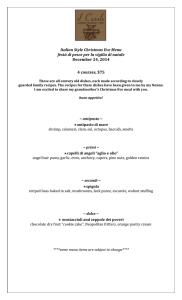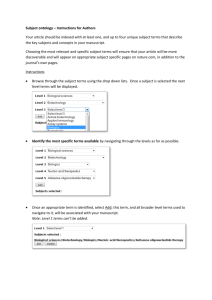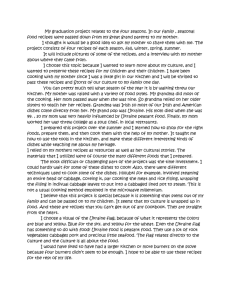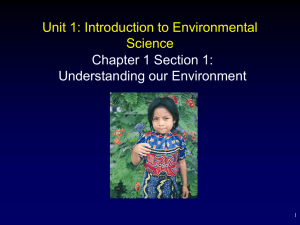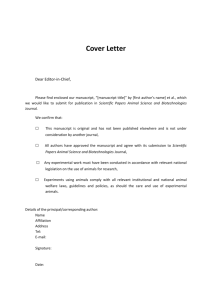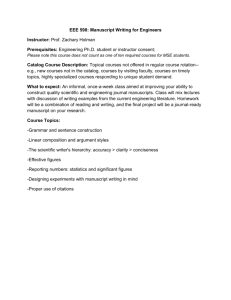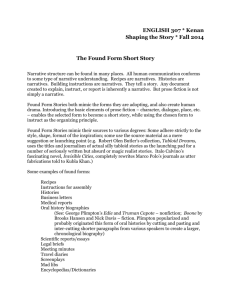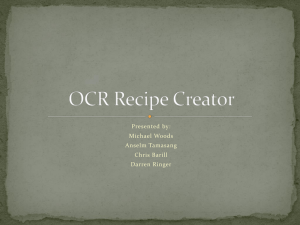Ancient and modern knowledge in medical technologies
advertisement
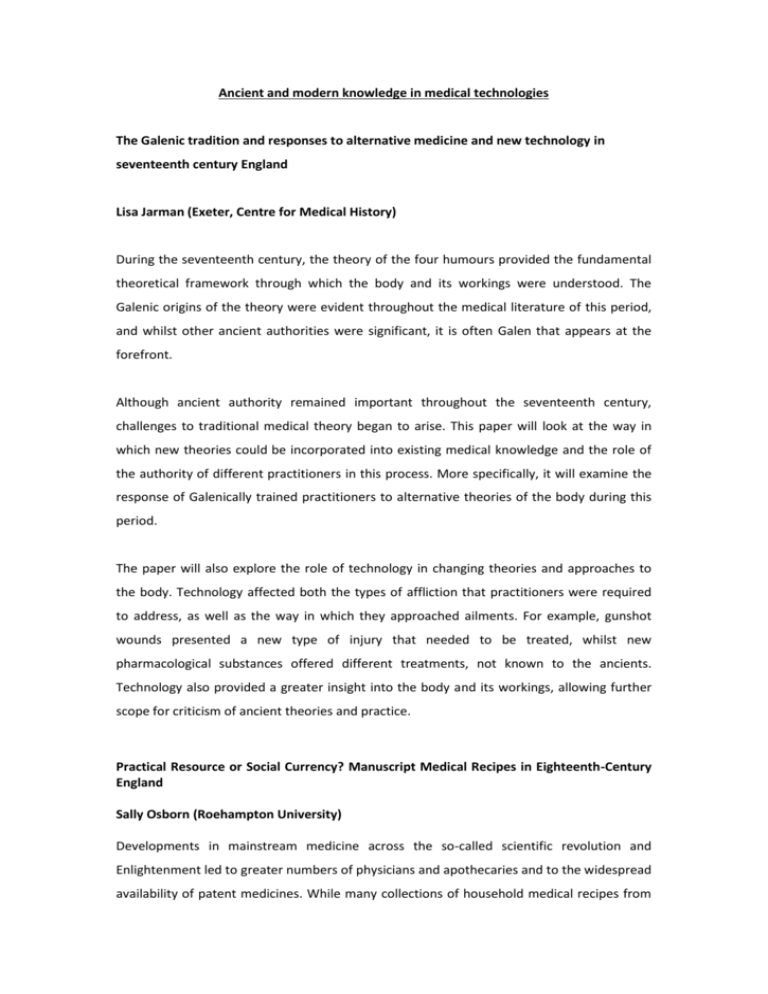
Ancient and modern knowledge in medical technologies The Galenic tradition and responses to alternative medicine and new technology in seventeenth century England Lisa Jarman (Exeter, Centre for Medical History) During the seventeenth century, the theory of the four humours provided the fundamental theoretical framework through which the body and its workings were understood. The Galenic origins of the theory were evident throughout the medical literature of this period, and whilst other ancient authorities were significant, it is often Galen that appears at the forefront. Although ancient authority remained important throughout the seventeenth century, challenges to traditional medical theory began to arise. This paper will look at the way in which new theories could be incorporated into existing medical knowledge and the role of the authority of different practitioners in this process. More specifically, it will examine the response of Galenically trained practitioners to alternative theories of the body during this period. The paper will also explore the role of technology in changing theories and approaches to the body. Technology affected both the types of affliction that practitioners were required to address, as well as the way in which they approached ailments. For example, gunshot wounds presented a new type of injury that needed to be treated, whilst new pharmacological substances offered different treatments, not known to the ancients. Technology also provided a greater insight into the body and its workings, allowing further scope for criticism of ancient theories and practice. Practical Resource or Social Currency? Manuscript Medical Recipes in Eighteenth-Century England Sally Osborn (Roehampton University) Developments in mainstream medicine across the so-called scientific revolution and Enlightenment led to greater numbers of physicians and apothecaries and to the widespread availability of patent medicines. While many collections of household medical recipes from this time have survived in manuscript form, it is often difficult to tell how much these were really used, or whether they were being replaced by proprietary remedies and ready-made ingredients. This paper will report on an ongoing research project into the ingredients and methods in and the usage of manuscript medical recipes, and how this changed over the course of the eighteenth century. Based on evidence from the recipes themselves and from contemporary letters and diaries, it will consider who collected such recipes, how and why, and what this tells us about the role of domestic healthcare in the context of growing professionalisation. It will address issues such as the use of recipes as a form of ‘social currency’, whether proprietary medicines had an impact on the content of home remedies and vice versa, and how domestic medical practices were shaped by changing notions of the domestic and gendered behaviour within the household. Sally Osborn is a PhD student at Roehampton University, researching the history and social context of 18th-century manuscript medical recipes. She has an MA in Historical Research from Roehampton and a BA in Humanities from the Open University. She also runs her own business as a book editor and typesetter. Secret Abortifacients? Treatments for Provoking the Menses in Early Modern Medical Texts Michelle Payne (Sussex) In the early modern medical texts that deal with women’s physiological functions there is a preoccupation with provoking menstruation. Good menstruation was seen to purge the woman of excess humours and help her fluids flow freely through her body. Amenorrhea was seen as potentially hazardous. If a woman did not menstruate properly then she was susceptible to a range of symptoms that included pains in her head which could carry towards her eyes, neck, shoulders and joints. She was vulnerable to dizziness, trembling, her urine turning black or reddish, and a loathing of her meat. Ill humours would be kept in her body, creating more ailments, and the unshed blood in her womb might turn into an abnormal growth. Equally the blood might run back into her brain, causing her to become overheated and troubled with melancholy which might even lead to suicide. Similarly she could suffer from green sickness or suffocation of the mother. It is no wonder then that medical practitioners wrote extensively on remedies for provoking the menses. But is there something else going on here? In this paper I argue that many of the remedies for provoking the menses were in fact disguised terminology for procuring an abortion. John Riddle and Angus McClaren have shown how in the Ancient World, the knowledge of plants and herbs to provoke abortion were freely available. Aristotle argued for termination to be induced before sense and life had begun in the embryo, to limit the size of a family, whilst Plato called for all women over the age of forty to have abortions as a matter of state policy. Galen, Dioscorides and Soranus all wrote about herbs and suppositories to induce abortion. In the later Middle Ages the Church officially detested and prohibited the practice, following the teachings of Thomas Aquinas who taught that all life began at conception. Therefore medical writers would have to be circumspect when putting into print treatments for amenorrhoea that might deliberately or inadvertently lead to termination of pregnancy. Recent work has shown that a substantial number of remedies for menstrual problems had well known abortifacient properties. In this paper I claim that remedies for abortion were readily available in the medical texts if one knew how to read between the lines. I argue that there is a compelling case to be made that the wisdom of the ancients was not lost to the early modern medical writers. Physicians and midwives had a vast pharmacopeia to deal with unwanted pregnancies, written under the guise of provoking the menses.
